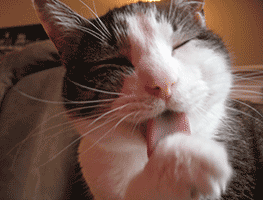Alarm Clock Cats
Has your cat woken you up at 3am? When your cat is locked out of the bedroom, does he or she cry loud enough to wake the neighbors? Or does your cat throw themselves repeatedly at the bedroom door?
Do not worry. We have some good news. Your cat is following their natural instincts! Cats are most active at dawn and dusk. Understanding their behavior may help understand why your kitty is most playful at precisely the same time that you are ready to wind down. Even though these are natural instincts, there are several ways to help reset your cat’s schedule to better align with your daily life and allow you to get the sleep you need. .jpg)
Step 1: Ignore Your Cat
Ignore your cat when they are engaging in the unwanted behavior. If you put food in their bowl to quiet them, pet them, or initiate play, you are reinforcing the unwanted behavior. This may not be easy, but ignore them and stay consistent.
Do not punish or yell at your cat. They are simply acting likes cats and following their natural instincts. As cat owners, it is our job to help set our cats up to successfully sleep at night and be active during the day.
Step 2: Play Therapy
In addition to ignoring your cat when they wake you, try this easy technique based on the typical activity cycle that a cat goes through as a natural predator: Hunt, Feast, Groom, and Sleep. For the indoor cat, following these four phases will help them feel satisfied. They will have the benefit of stimulation, activity, and food in a way that follows their natural behavior.
Before bedtime, engage your cat in an interactive play session using a wand-type toy, such as the Cat Charmer or the Feline Flyer. Move the toy like prey and allow your cat to stalk, pounce, and capture. The game should last about fifteen minutes, but you can alter this based on your cat’s physical ability, age, and health. Wind the action down at the end of the game so your cat is left relaxed.
Once the game is over, it is time to feast! If you feed your cat on a schedule, divide their normal daily portion so you can offer them a final post-game snack. If you free feed, offer a small snack of canned food. After the meal, your cat will most likely engage in a grooming session and then be ready to snooze. If you find your cat still wants interaction, set out special toys for evening playtime only.
Step 3: Increase Daily Enrichment
Set up your home environment to increase your cat’s physical and mental enrichment. If your cat is awake, they are more likely to sleep through the night. The following examples are ways to increase your cat’s daily enrichment: Keep puzzle/treat dispensing toys out for your cat to enjoy.
- Provide a cat tree, window shelf, hammock bed, or other resting area for your cat to watch outdoor evening activities.
- Add wall shelves, cat skywalks, and other climbing/perching additions to your home.
- Participate in daily interactive play sessions with your cat
- Take field trips outside. Remember to keep your cat safe by using a leash or outdoor cat enclosure (see the Leashing Training handout for details).
For more information, see the Enriching Your Cat’s Life handout containing an extensive list of enrichment ideas and how to implement them.

